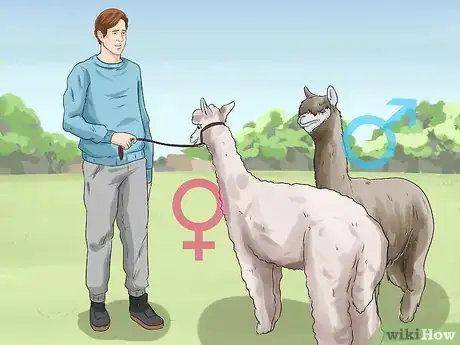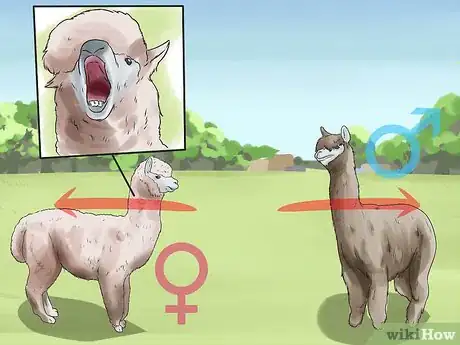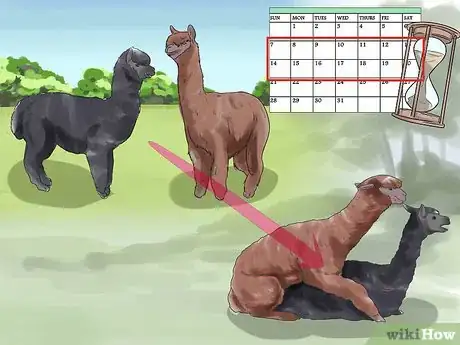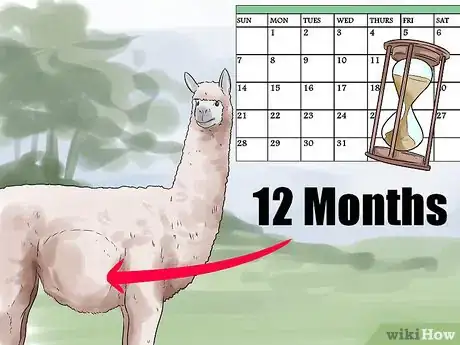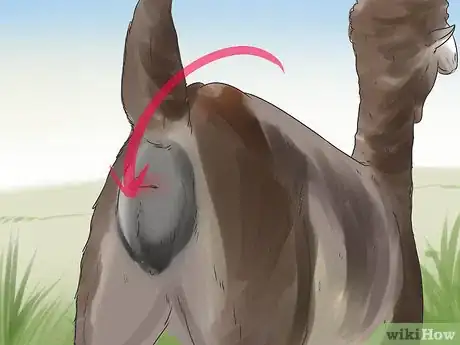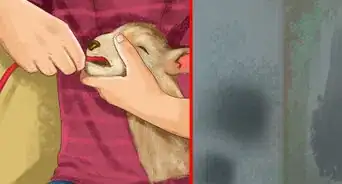This article was co-authored by wikiHow Staff. Our trained team of editors and researchers validate articles for accuracy and comprehensiveness. wikiHow's Content Management Team carefully monitors the work from our editorial staff to ensure that each article is backed by trusted research and meets our high quality standards.
wikiHow marks an article as reader-approved once it receives enough positive feedback. In this case, 85% of readers who voted found the article helpful, earning it our reader-approved status.
This article has been viewed 64,513 times.
Learn more...
There are many benefits to breeding alpacas. You may want to breed alpacas because of their friendly temperament and because they are easy to train and enter into shows. Alpacas can also be a sound investment, offering a wool like fiber that is as fine as cashmere and softer than a sheep’s wool. Because alpacas adapt to various environments and take to farm living well, breeding alpacas is a great way to increase your herd, or you may choose to sell your young alpacas for a profit.
Steps
Selecting the Right Alpacas
-
1Purchase alpacas. If you don’t already have any alpacas, you will need to purchase a breeding pair before you can have them mate. Alpacas are not inexpensive, but many farms offer in-house financing to help you to afford quality animals. A breeding female can range in price from $5,000 to $40,000 and a breeding male will likely cost between $5,000 and $50,000. Some exceptional males have even been sold for as much as $200,000! Expect to spend a minimum of $10,000 for a healthy male and female alpaca to begin your breeding process.
- The best way to find alpacas for sale is on the Alpaca Owner’s Association’s registry.
- If you purchase your alpacas from a local farm, you may want to have a veterinarian look the animals over prior to your purchase to ensure they are healthy and able to breed.
-
2Ensure the female is of appropriate breeding age. It’s common for breeders to want to maximize their financial return on a breeding female alpaca, and as a result they begin breeding them at too young an age. Alpacas traditionally reach breeding maturation sometime between twelve and twenty-four months, with some as late as thirty. While some alpacas have successfully conceived as young as five months, this is not safe for the female or the baby.[1]
- Breeding your female alpacas too young can lead to complications that can endanger the lives of the female and baby alpacas.
- Make sure your female alpaca weighs at least eighty-eight pounds before allowing her to breed.
Advertisement -
3Choose an appropriate breeding male. Male alpacas are usually ready to mate for the first time at between one and three years of age. You can be sure a male alpaca is matured enough to breed when its penis separates from the prepuce. Male alpacas that are not matured enough to breed physically will be unable to mate and will likely demonstrate little interest in attempting to do so.
- When the male alpaca matures sufficiently to breed, its genitals will detach from the body and hang freely.
-
4Ensure both the breeding male and female alpacas are healthy. This step is often overlooked because people tend to assume their animals are in good health. Remember that the health of the baby alpaca will be determined in great part by the health of each of its parents, so it’s important to ensure they are both in optimal health. It is especially important that the female alpaca is in good health due to the relative size of their offspring. Baby alpacas are often born weighing around twenty pounds, with a mother that weighs only about one hundred and fifty.
- Make sure your alpacas are well fed and that their nutritional needs are met.
- Ensure you give a breeding female alpaca enough time to fully recover from giving birth before you breed them again. They are often healed after two weeks, but may be stressed by nursing a baby for up to six months.
- You may want to have both alpacas looked over by a veterinarian to ensure they are free of parasites and in good health.
-
5Create a separate breeding pen. Alpaca breeding behavior can be enhanced by establishing the proper setting. Construct a separate breeding pen and ensure it is positioned in an area that can’t be seen by any other male alpacas you have. Ensure your breeding pen is on flat, even terrain so the male alpaca can maintain its balance while mating.[2]
- The breeding pen should be fairly small. Make sure it is only two to three times larger in area than the space your male and female alpaca occupy so they can move freely but have to interact.
- Minimize distractions by removing everything from the breeding pen except the two alpacas.
Encouraging Reproduction
-
1Expose the breeding male to the female. Male alpacas will make it clear that they want to breed by singing or “orgling.” This sound is evidence that the male alpaca is mature and healthy enough to breed and has taken an interest in the female alpaca nearby.
- An alpaca orgle can be fairly high pitched and is created by the reverberations of the alpaca’s vocal chords.
- The orgle sounds almost like a small engine running and is quite distinct from normal alpaca noises.
-
2Induce ovulation in the female alpaca. Female alpacas are “induced ovulators” which means the act of intercourse or presence of alpaca semen can make them ovulate. Because alpacas do not have an estrous cycle like many other mammals, the female may need to be bred more than once; the first to induce ovulation and the second to impregnate the animal.[3]
- A single mating is usually sufficient to make ovulation occur, but will likely not impregnate the alpaca.
- Female alpacas may be induced to ovulate by being in close proximity to another mating pair of alpacas if you intend to breed multiple alpacas simultaneously.
-
3Place the male and female alpaca in the breeding pen. Most alpacas will breed with very little human involvement. Because alpacas are induced ovulators, artificial insemination is less successful than it is in other livestock breeds, so natural mating offers the highest chances of successfully breeding your alpacas. Place both of the alpacas in the breeding pen and allow them to interact.[4]
- If the female is receptive to mating, it will sit in a “cush” position, which looks like laying on its stomach with its legs folded beneath it.
- The male will continue to orgle as it woos and ultimately mounts the female.
-
4Separate the alpacas if the female is not receptive. Female alpacas may not be ready to copulate when placed in a breeding pen with a male. A female alpaca demonstrates that she is not ready to copulate by “spitting off,” which is the act of actively avoiding the male, keeping its ears down and actually spitting away from or directly at the male alpaca.[5]
- Spitting off usually occurs when the female alpaca is stressed by its environment or does not feel healthy enough to breed.
- Separate the alpacas and attempt to resolve any stressors in the environment. If you do not separate them, the female may injure herself by attempting to get out of the pen.
-
5Wait a week or two after copulation to re-mate alpacas. Some alpacas may actually become impregnated from the initial copulation, but the often only begin to ovulate as a result. A week after ovulation, place the breeding male and female back in the pen and observe their behavior.[6]
- If the female enters a cush position and allows itself to be mounted, it is likely ovulating.
- If the female “spits off” and avoids the male, it may either not be ovulating, or it may actually be pregnant.
- Repeat this process in two more weeks to see if the female is receptive to mating or avoids it.
Waiting for the Results
-
1Place the breeding pair together to determine pregnancy. The easiest way to determine if an alpaca is pregnant is to continue to place her in the breeding pen with the breeding male every two weeks. If the female did not become pregnant with the last mating, it will enter a cush position and allow itself to be mounted again. A pregnant female, on the other hand, will “spit off” from the male, lower its ears and avoid it.[7]
- A female will likely allow copulation every two weeks until it has conceived, after which it will not allow the male near enough to mount.
-
2Use a blood test and ultrasound to confirm pregnancy. Once a mated female begins to “spit off” the breeding male, you can use a blood test to determine if the alpaca is pregnant. Blood tests measure the level of progesterone in the female’s body which can be a strong indicator of pregnancy, but can yield false positives. While you may be able to purchase livestock pregnancy tests from retailers, your best option is to have a veterinarian conduct the blood test. If the blood test comes back positive, have the veterinarian conduct an ultrasound to confirm the pregnancy.[8]
- An ultrasound is the most reliable method of determining if an alpaca is pregnant.
- Conduct further “spit off” interactions with the breeding male every 8-12 weeks after a confirmed pregnancy to verify the pregnancy is continuing and has not been reabsorbed.
-
3Wait for eleven to twelve months. Alpacas have long gestation periods for the fetus to develop. It usually takes about eleven and a half months for an alpaca to carry to full term and give birth to an offspring. Alpacas usually carry only one baby, or cria, at a time. While twins are possible, they are quite rare.[9]
- After ten months you will often be able to feel the fetus by palpating the abdominal wall of the female.
-
4Look for signs of imminent delivery. Female alpacas that are going to give birth soon will shift their behavior in the days leading up to it. While these behaviors are not always easy to identify, careful observation may give you an advanced warning that your alpaca will soon enter labor. Look for these signs:[10]
- The female will separate itself from the herd and avoid interaction with others.
- The female’s udders, vulva and anus may all become swollen or puffy.
- The cervix plug is ejected from the female. This usually indicates birth will occur that day or the one immediately following it.
-
5Allow the alpaca to give birth on its own. You may want to be present when your alpaca gives birth to help if there are any complications. If things progress normally, it’s best to allow the mother alpaca give birth on its own with limited stressors introduced by your interaction with it. Alpacas almost always give birth in the morning and very rarely go into labor in the afternoon or evening hours.[11]
- If the cria, or baby alpaca, leaves its mother facing upward, you should contact a vet as their may be a complication with the delivery.
- It is normal for the cria to hang from its mother during the birthing process for up to five minutes.
- Crias should emerge head and hooves first. If it begins to come out backward, contact a vet immediately.
-
6Let the herd to welcome its new member. After a female gives birth, it may take a few hours to expel the placenta and for the newborn cria to emerge from the fine membrane covering it as it is born. This membrane dissolves, but you may want to allow the mother to lick the membrane off its young to expedite the process. The cria will then begin nursing and the other members of the herd will likely approach the mother and new cria.[12]
- Alpacas are herd animals, so it’s important that you allow the herd to interact with its new member.
- You may want to bring the cria to a vet after 24 hours to make sure it is healthy.
Community Q&A
-
QuestionIf a female gets pregnant while nursing, can she still nurse?
 KarinTop AnswererYes. Pregnancy does not affect milk production in a female alpaca.
KarinTop AnswererYes. Pregnancy does not affect milk production in a female alpaca. -
QuestionHow long after giving birth can my alpacas breed again?
 Community AnswerIn theory, a female alpaca can be bred again two weeks after giving birth. It is advisable, however, to let her skip a year every once in a while.
Community AnswerIn theory, a female alpaca can be bred again two weeks after giving birth. It is advisable, however, to let her skip a year every once in a while. -
QuestionHow old is too old for a breeding female?
 Community AnswerNature usualy solves this problem itself: if a female is too old, she will not get pregnant.
Community AnswerNature usualy solves this problem itself: if a female is too old, she will not get pregnant.
References
- ↑ http://www.bonnydoonalpacas.org/breeding.html
- ↑ http://www.bonnydoonalpacas.org/breeding.html
- ↑ http://www.thealpacaplace.co.nz/articles/breeding-and-reproduction/breeding-alpacas/
- ↑ http://www.thealpacaplace.co.nz/articles/breeding-and-reproduction/breeding-alpacas/
- ↑ http://www.thealpacaplace.co.nz/articles/breeding-and-reproduction/breeding-alpacas/
- ↑ http://www.thealpacaplace.co.nz/articles/breeding-and-reproduction/breeding-alpacas/
- ↑ http://www.thealpacaplace.co.nz/articles/breeding-and-reproduction/breeding-alpacas/
- ↑ http://www.thealpacaplace.co.nz/articles/breeding-and-reproduction/breeding-alpacas/
- ↑ http://bigmeadowcreekalpacas.com/About%20Alpacas/AlpacaReproduction.htm





